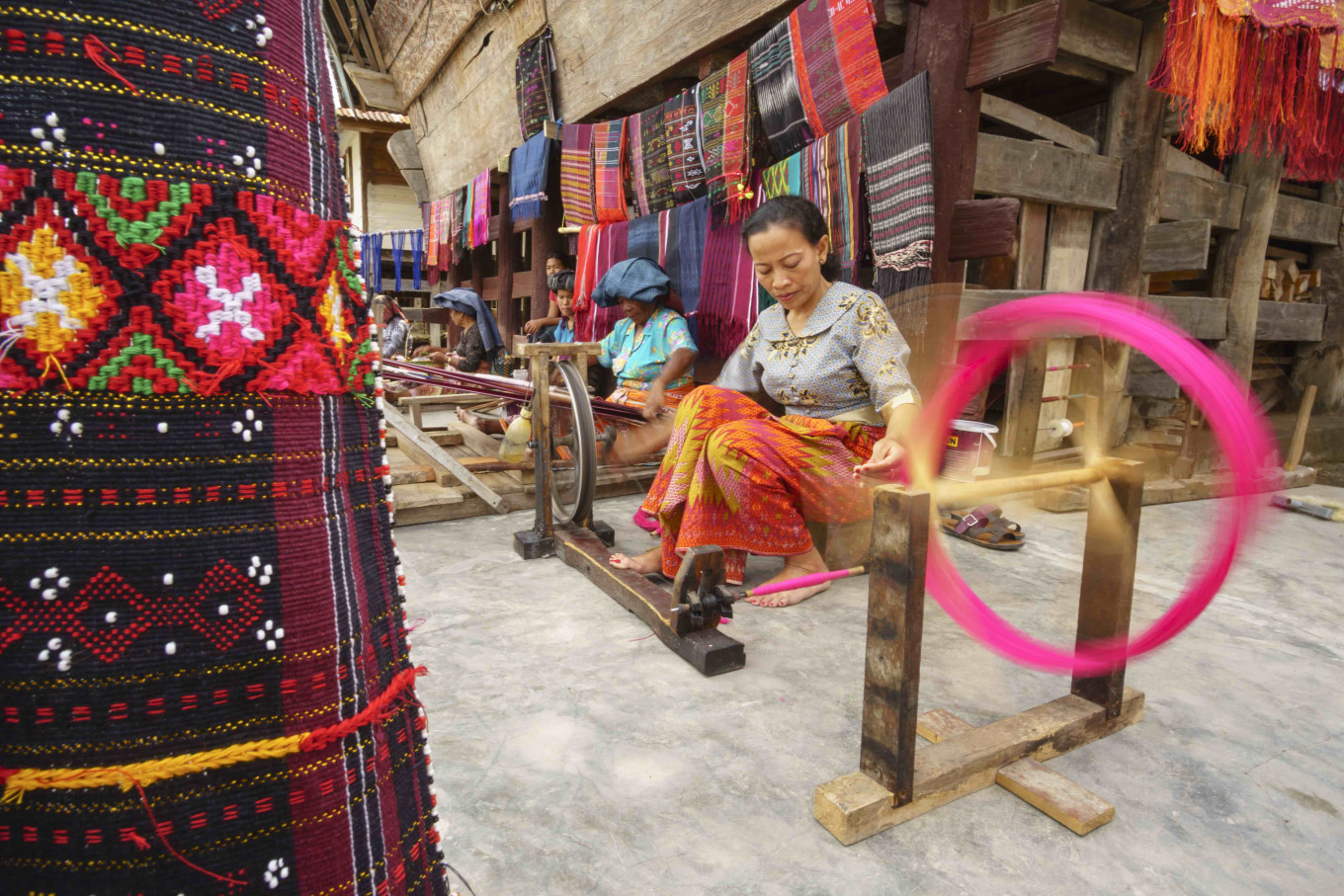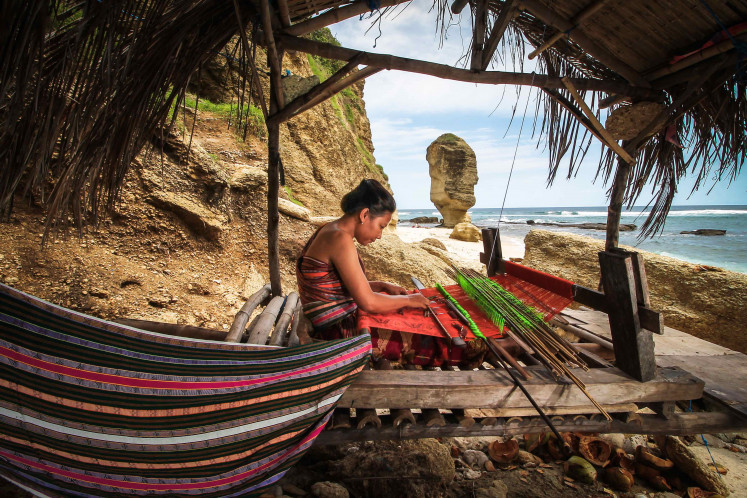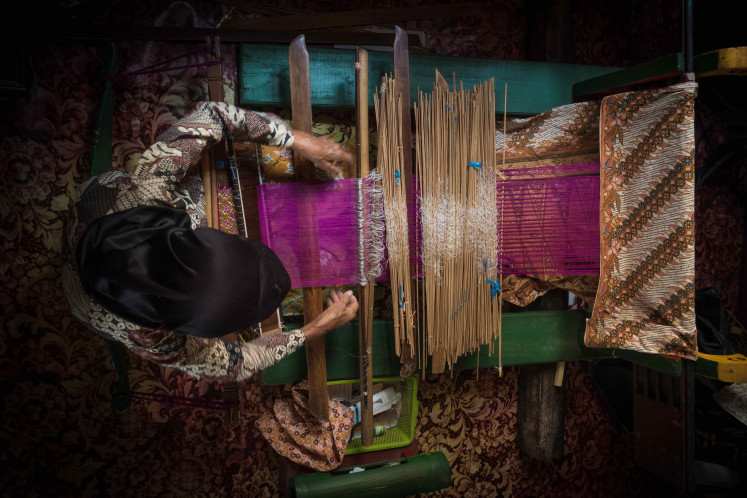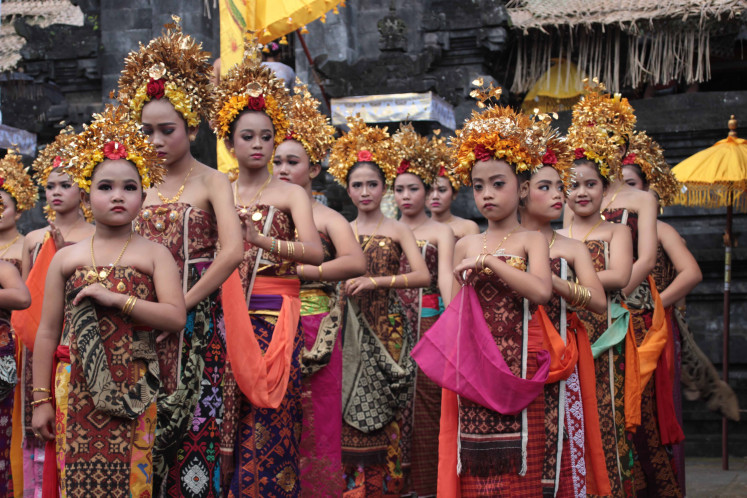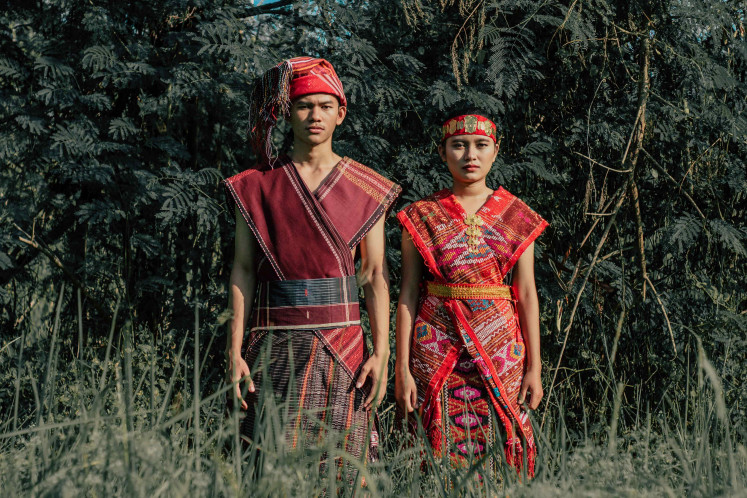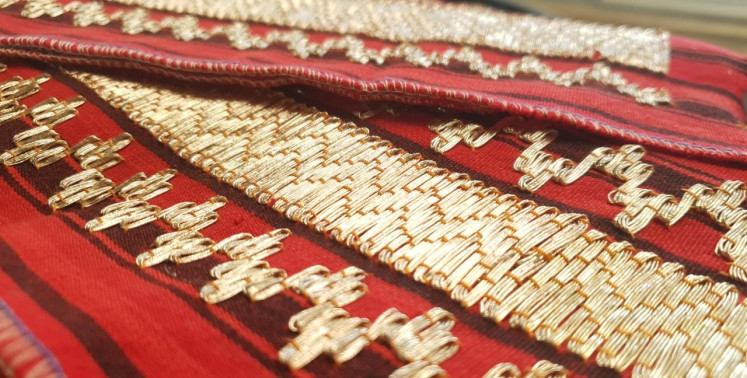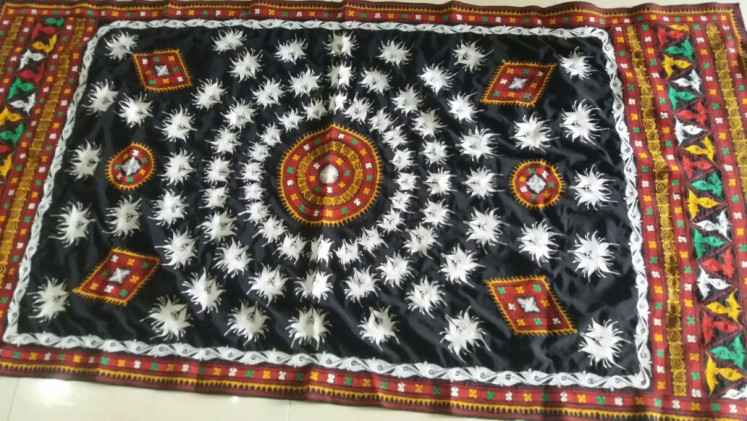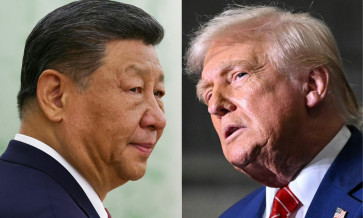Popular Reads
Top Results
Can't find what you're looking for?
View all search resultsPopular Reads
Top Results
Can't find what you're looking for?
View all search resultsTwenties: 20 exquisite traditional fabrics of Indonesia
'Twenties' is a column in which we give our top 20 list of anything and everything of interest, from food and history to pop culture, lifestyle and more.
Change text size
Gift Premium Articles
to Anyone
'Twenties' is a column in which we give our top 20 list of anything and everything of interest, from food and history to pop culture, lifestyle and more.
There is more to the archipelago's traditional, heritage fabrics than the popular batik. Filled with meaning within their traditionally woven threads, these fabrics are undeniable evidence of Indonesian creative wealth.
Songket Lombok
Songket Lombok (traditional woven fabric from Lombok) is generally made from colorful cotton threads topped with a signature silver or gold touch. It is often used during traditional ceremonies as belts and scarves. Sasak women learn to make Lombok woven cloth from an early age as part of the requirements for them to get married. With seven distinctive motifs, ranging from the Subahnale to Bintang Empet, the Lombok Songket motif reflects the various values of the Lombok people. For example, the Bintang Empet motif is inspired by the ancestral calendar that determines the rainy or dry seasons in the region.
Tradition: Sasak women learn to make Lombok woven cloth from an early age as part of the requirements for them to get married. (Wikimedia Commons/Suryasriyama) (Wikimedia Commons/Suryasriyama)Songket Palembang
Songket Palembang has been known to exist in South Sumatra since the time of the Sriwijaya Kingdom in the 7th century and the Palembang Darussalam Sultanate in the 17th century as part of royal-only fashion routine. Woven from cotton, bark, pineapple fiber, banana fiber or palm leaf threads called lusi or lungsin and decorated with silk and gold thread, Songket Palembang has many motifs and meanings with Songket Lepus (to cover) being the oldest.
Workshop: Pictured is the traditional weaving process of Songket Palembang. (Wikimedia Commons/Afrinaldi Zulhen) (Wikimedia Commons/Afrinaldi Zulhen)Songket Lepus is completely covered with gold threads and is usually given as a dowry from the groom to the bride as it is believed to bind the newlyweds with love.
Tenun Gringsing
Carrying a name derived from gring (drought, plague or disease) and sing (to repel), Tenun Gringsing comes from Tenganan Traditional Village in Karangasem, Bali. Tenun Gringsing is believed to have magical powers that can protect the wearer from calamity and distress, and even cure diseases.
Ready to move: Rejang Ala Tenganan dancers in Karangasem, Bali are seen wearing Tenun Grinsing. (Wikimedia Commons/Kresnanta) (Wikimedia Commons/Kresnanta)Making Tenun Gringsing usually begins with a ritual process and the weavers must also make sure that they have no potential impurities as they weave. For example, the weaver (usually a woman) should not be on her period during the process of weaving.
Tenun Buna (Bet Naek)
Tenun Buna is also believed to protect the wearer from natural disturbances, evil spirits and disasters.
Originates from North Central Timor, like in the case of Songket Lombok, the ability to weave Tenun Buna is said to be one of the conditions for a woman to be considered worthy of marriage. Apart from functioning as daily clothing, Tenun Buna is also used as clothing for traditional events, as a dowry or "belis nikah" in the local language, as a medium of monetary exchange, a symbol of appreciation or respect and even as a means of redeeming customary sanctions.
Ulos
The ulos (cloth in Batak language) has been produced by the Batak community in North Sumatra since the 14th century, as it was introduced to hand looms from India. Ulos is made using a loom instead of a weaving machine.
Heritage: The Ulos was established as an intangible cultural heritage by the Education and Culture Ministry in 2014. (Wikimedia Commons/Angeline Claudia) (Wikimedia Commons/Angeline Claudia)There are many types and uses of ulos. For example, Ulos Antak-Antak and Ulos Bolean are usually worn during mourning, while Ulos Mangiring and Ulos Bintang Maratur are given as a "parompa" (sling) for a newborn in the hope that the birth would be followed by another within the same family.
Tenun Ikat Flores
For the people of Flores Island, Sumbawa, Tenun Ikat is not just a cloth but also a symbol of status, wealth, power and dignity. According to local people's beliefs, certain motifs of this woven cloth can make the owner rich. Flores women who enter adolescence are required to wear woven cloth and lengthen their hair so they can be worn in particular bun styling after getting their period. Tenun Ikat itself is commonly used by people of various tribes in Flores as a complement to clothing, such as worn as a scarf or sarong.
Kewatek Nai Rua
Kewatek Nai Rua is a woven fabric usually intended for use by women or dowry typical of Lembata, East Nusa Tenggara, which comprises two pieces of fabric joined together — similar to the Kewatek Nai Telo fabric, which has a higher value as it is made up of three connected parts.
Kewatek weaving can take up to months and even years. Traditional weavers use several types of plants to make kewatek, such as noni roots for red dye or tarum (indigo) leaves for blue dye, with some being only available in certain seasons, making the process exceptionally lengthy.
Lipa' Sabbe (Buginese Woven Silk Sarong)
Commonly known to be produced in Bone, Wajo and Soppeng in South Sulawesi, Lipa' Sabbe (Bugis silk-woven sarong) is the result of cross-cultural creations on the Silk Road, where the Buginese were exposed to sabbe (silk fabric) imported from Gujarat in the ninth century. The Buginese silk woven sarong has various patterns, such as the Ballo Makalu, Ballo Renni, Cabos or Lagosi.
The Buginese are also known to use the sarong for the Sigajang Laleng Lipa tradition, where two people at odds will face each other in a badik knife fight while being wrapped in one sarong together.
Lurik
Lurik is a cotton cloth with small striped motifs traditionally the clothing of rural Javanese men. In ancient times, lurik was made from cotton threads spun by hand and then woven into a piece of cloth with a tool called a gedog.
The Javanese believe that lurik weaving has mystical powers within its specific patterns. For instance, the “strong” kluwung and tuluh watu patterns are used for the ruwatan (exorcism) ceremony.
Tapis
Tapis is a traditional weaving craft of the Lampung people, who are divided into various tribes. Each tribe is said to have at least a dozen of its own motifs for different social strata and traditional events. Tapis cloth is made from woven cotton threads and gold threads that are applied with a special embroidery method called "cucuk".
Learning phase: Novice crafter would train using synthetic wool threads or cotton threads before they can finally able to embroider gold thread onto Tapis. (Courtesy of OHMG) (Courtesy of OHMG/Courtesy of OHMG)In contrast to ordinary embroidery, cucuk embroidery uses two types of threads — decorative and retaining threads. The decorative thread, usually gold or silver, is laid on a striped woven fabric and then held in place with cotton threads.
Kain Kapal
Originating from South Lampung, kain kapal (ship cloth) is usually not worn but used as nampan (upholstery), tatibin (decorations) and pelepai or palepai large (wall decorations). The fabric usually consists of three parts: The border and the main motifs — which usually consist of (jung) ships surrounded by filler motifs.
Split into three parts three parts, the different sections are related to the lower realm, the human realm and the upper realm of life — a depiction of the journey of the spirit of the recently deceased to the afterlife. However, as Islam is now the majority religion in the region, it is now no longer interpreted as a journey into death but a journey of one's life.
Sasirangan
According to the folklore about Patih Lambung Mangkurat from Negara Dipa and Princess Junjung Buih, the sasirangan cloth was first made in the 12th century AD in South Kalimantan. The people of South Kalimantan believe that sasirangan cloth can cure various diseases, especially when the cloth is yellow with green edges and a red diamond motif.
The sasirangan cloth is smoked with incense with a Salawat (praise to Prophet Muhammad) recited upon it every Monday and Friday night. After this process, the Sasirangan cloth is then worn by a sick person as a sarong, belt or headband.
Besurek
Besurek (“writing” in the Bengkulu dialect of Malay) is a typical batik from Bengkulu with Arabic calligraphy motifs, which is said to have been created during the migration of Prince Sentot Alibasya and his family and followers to the Bengkulu area.
Unique touch: Besurek typically incorporates Arabic caligraphy into its patterns. (Flickr/Peter D. Tillman) (Flickr/Peter D. Tillman)Besurek cloth is used in various activities of the Bengkulu people, ranging from traditional wedding ceremonies, births and funerals. The besurek motif called Rembulan (the moon), for example, is commonly worn by the bride and groom in the pre-wedding siraman ceremony and has the meaning of giving praise to God.
Tenun Ulap Doyo
Tenun Ulap Doyo is a type of ikat woven fabric specially made from doyo leaf fiber (Curliglia latifolia), a type of pandanus that grows on the island of Borneo. A typical cloth of the Dayak Benuaq community in Tanjung Isuy, Ulap Doyo’s motifs, colors and decorations hide spiritual, aesthetic and functional values. For example, the timang or tiger motif symbolizes the strength of a man while Ulap Doyo with black and white stripes indicates that the wearer can treat all forms of magic and disease.
Tenun Buton
The history of the weaving tradition in the Buton community, Southeast Sulawesi, is estimated to have existed since the 14thcentury. The heritage of woven culture is strong in this region — this can also be seen in the use of kampua, a type of weaving that became the currency during the reign of Sultan Dayanu Ikhsanudin (1597 – 1631).
The traditional Tenun Buton’s motifs are simple, usually featuring simple straight lines and colors based on the wearers’ status. For example, the straight vertical lines are a motif for women, while the fabric for men comes with a plaid pattern.
Tenun Dayak
Tenun Dayak is traditionally made by the Dayak people in Kalimantan through the ikat method to be worn or displayed at homes. It is believed to have the power as a medium to interact with the spirits of the dead. As it functions as ritual equipment typical of the community, there are many requirements for the weavers, such as getting the revelations about the motif to be woven through dreams first to ensure completion. In ancient times, the motifs of Dayak woven fabrics were mostly shaped like humans, but the modern tenun usually feature plants and animals, signifying prosperity and good fortune.
Sarung Goyor
People in Central Java, especially in the Pemalang area, are said to have been making sarung goyor or goyor sarong with various motifs from 1980 until now. Currently, Sarong Goyor can also be found in Tegal, Gresik, Sragen, Jepara, Tuban and Pekalongan.
The word "goyor" itself means soft or gently draping, referring to the properties of this woven sarong. Typically, the goyor sarong is woven using high-quality rayon or cotton threads to form beautiful motifs, such as kembangan (flower), prilikan (minuscule) and nanasan (pineapple).
Tenun Donggala
Tenun Donggala are usually made by the women of Central Sulawesi when their husbands go out to sea for a long time. Therefore, many Donggala sarong motifs are related to family life. For example, the Buya Bomba pattern, with a plant motif, means sacred love for family and God.
The Buya Subi pattern, with diamond and flowery vines motifs, signifies the determination of a man's heart in proposing to his beloved woman and is a symbol of the unification of the families. Buya Awi, which tends to be plain in its motif, symbolizes a pure woman ready to marry her betrothed.
Tenun Hinggi
Tenun Hinggi, typical of West Sumba, is usually worn by Sumbanese men as shoulder coverings and is tied at the hips hanging down to the knees. Tenun Hinggi is also commonly presented as a gift and exchanged for family members or other social groups in Sumba with gifts such as gold, silver, weapons and horses — for example, in marriage proposals.
This rectangular ikat cloth is mainly decorated with animal motifs, such as a turtle that symbolizes loyalty or a horse, which is a symbol of strength and virility.
Kerawang Gayo
Kerawang Gayo cloth is usually worn by the Gayo tribe from Aceh when holding traditional events, such as weddings or dances. Kerawang Gayo woven cloth usually comes in a certain color which symbolizes the wearer’s mersik (courage), lisik (diligence) and urik (prudence) character.
Different name: Kerawang Gayo also has another name that is known locally in most regions in Aceh, which is 'Upuh Ulen Ulen'. (Wikimedia Commons/Victor Pogadaev) (Wikimedia Commons/Victor Pogadaev)The base is usually black with red motifs that symbolize mersik, white and green for lisik and yellow for urik. The motifs that are often found in traditional Gayo creations are mata itik (duck eyes), pucuk rebung (bamboo shoots), emun berangkat (drifting clouds), tulen iken and tulenni iken (fish), puter tali (double twist) and mata ni lo (the sun).
ohmg

